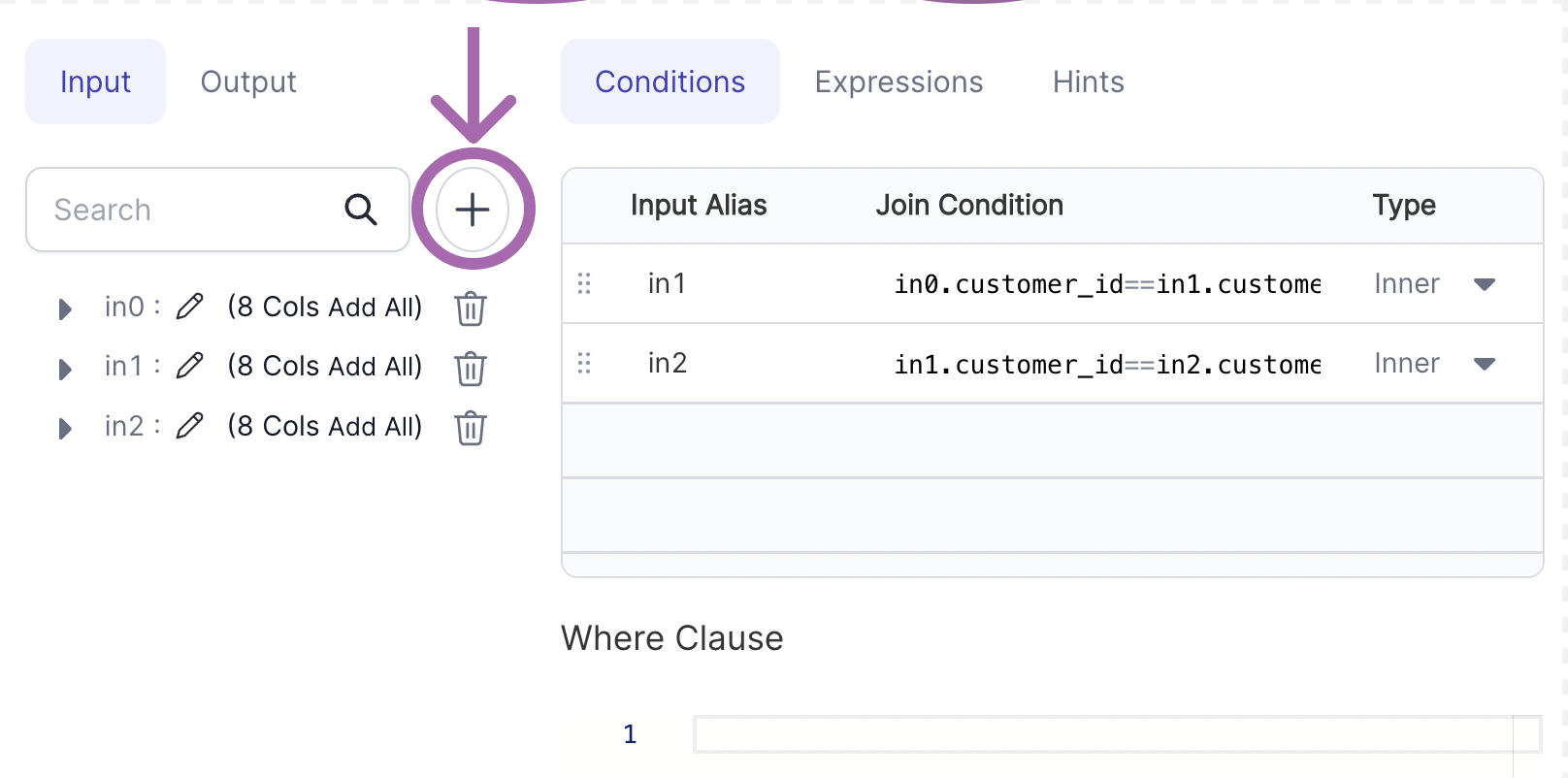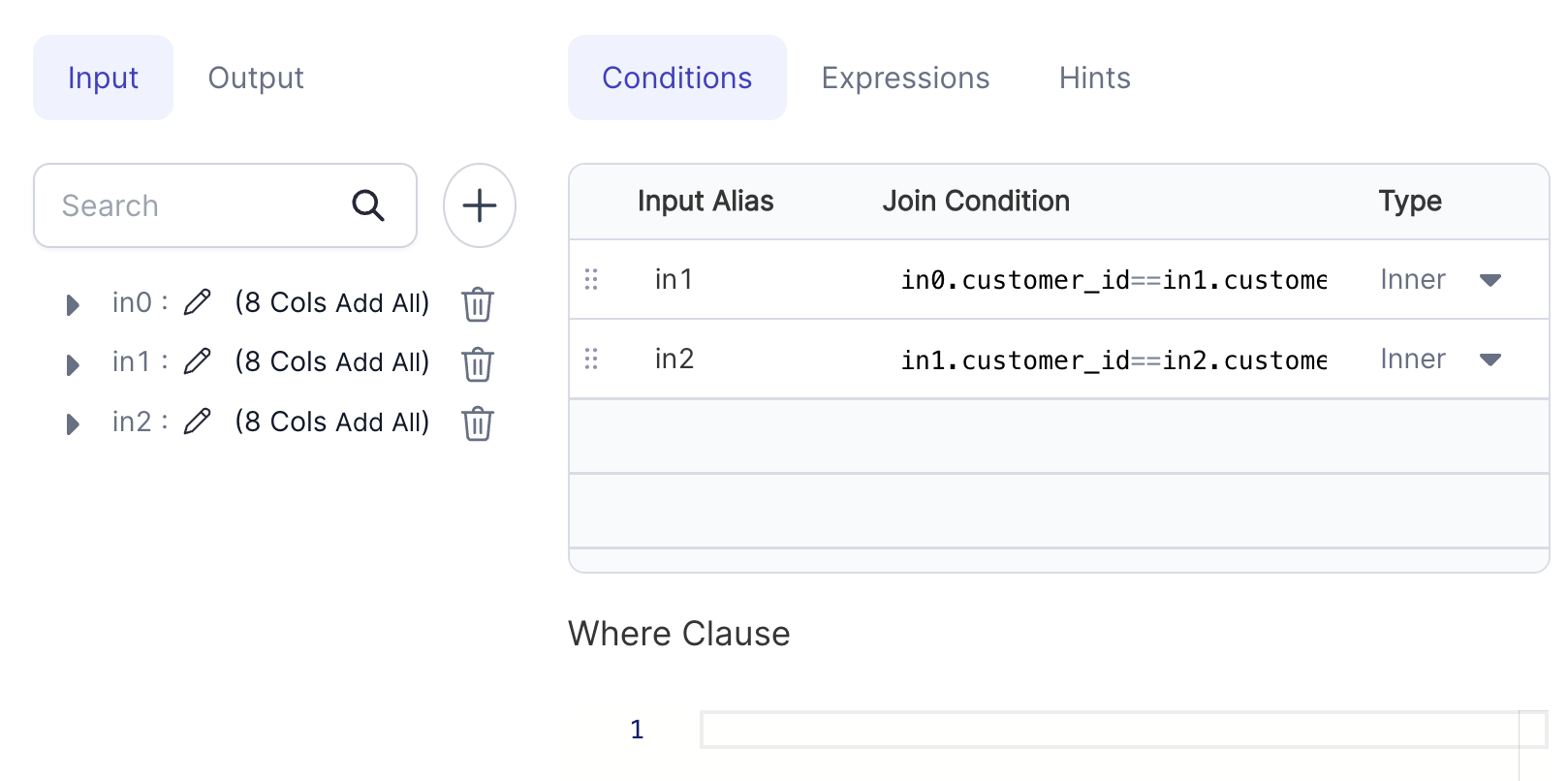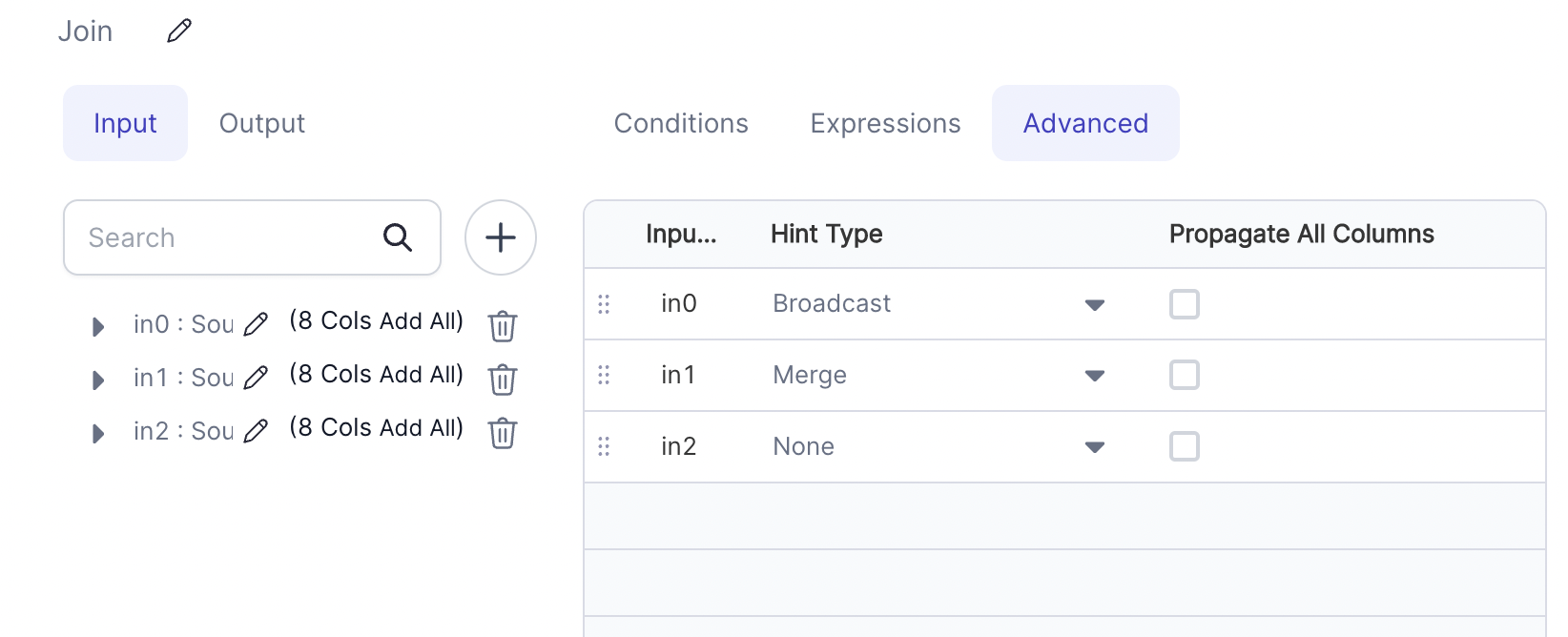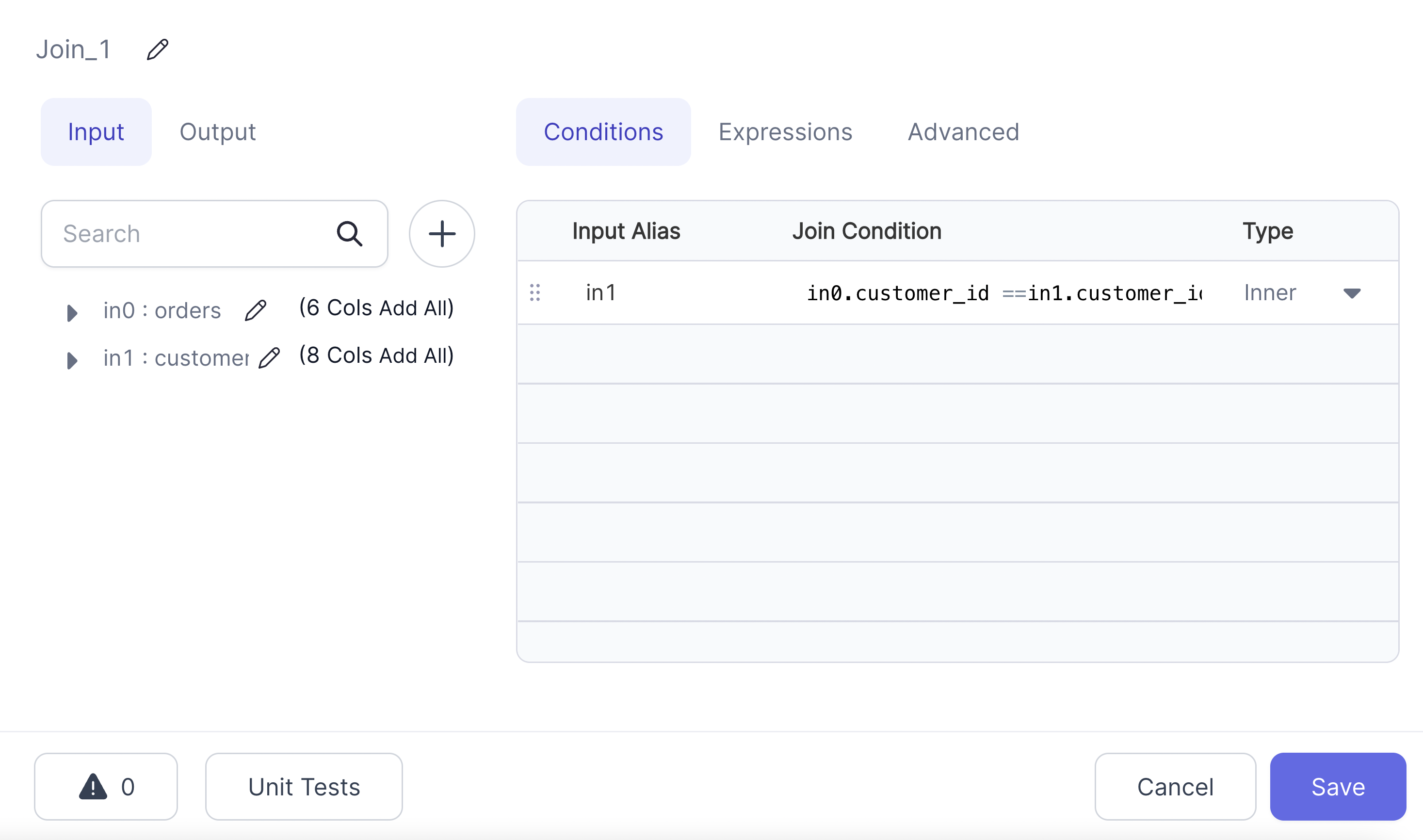Join
Joins 2 or more DataFrames based on the given configuration.
Parameters
| Parameter | Description | Required |
|---|---|---|
| DataFrame 1 | First input DataFrame | True |
| DataFrame 2 | Second input DataFrame | True |
| DataFrame N | Nth input DataFrame | False |
| Join Condition (Conditions tab) | The join condition specifies how the rows will be combined. | True |
| Type (Conditions tab) | The type of JOIN (Inner, Full Outer, Left , Right , Left Semi, Left Anti) | True |
| Where Clause (Conditions tab) | Filter applied after the Join operation | False |
| Target column (Expressions) | Output column name | False |
| Expression (Expressions) | Expression to compute target column. If no expression is given, then all columns from all DataFrames would reflect in output. | False |
| Hint Type (Advanced) | The type of Join Hint (Broadcast, Merge, Shuffle Hash, Shuffle Replicate NL or None). To read more about join hints click here | False |
| Propagate All Columns (Advanced) | If true, all columns from that DataFrame would be propagated to output DataFrame. Equivalent to selecting df.* for the selected DataFrame. | False |
Adding a new input
- Click on the plus icon to add a new input.
- Then add your condition expression for the newly added input.

Examples
Example 1 - Join with three DataFrame inputs

- Python
- Scala
def Join_1(spark: SparkSession, in0: DataFrame) -> DataFrame:
return in0\
.alias("in0")\
.join(in1.alias("in1"), (col("in0.customer_id") == col("in1.customer_id")), "inner")\
.join(in2.alias("in2"), (col("in1.customer_id") == col("in2.customer_id")), "inner")
object Join_1 {
def apply(spark: SparkSession, in0: DataFrame, in1: DataFrame, in2: DataFrame): DataFrame =
in0
.as("in0")
.join(in1.as("in1"), col("in0.customer_id") === col("in1.customer_id"), "inner")
.join(in2.as("in2"), col("in1.customer_id") === col("in2.customer_id"), "inner")
}
Example 2 - Join with Hints
Join hints allow users to suggest the join strategy that Spark should use. For a quick overview, see Spark's Join Hints documentation.

def Join_1(spark: SparkSession, in0: DataFrame, in1: DataFrame, in2: DataFrame) -> DataFrame:
df1 = in1.hint("merge")
return in0\
.alias("in0")\
.hint("broadcast")\
.join(df1.alias("in1"), col("in0.customer_id") == col("in1.customer_id"), "inner")\
.join(in2.alias("in2"), col("in0.customer_id") == col("in1.customer_id"), "inner")
object Join_1 {
def apply(spark: SparkSession, in0: DataFrame, in1: DataFrame, in2: DataFrame): DataFrame =
in0
.as("in0")
.hint("broadcast")
.join(in1.as("in1").hint("merge"), col("in0.customer_id") === col("in1.customer_id"), "inner")
.join(in2.as("in2"), col("in1.customer_id") === col("in2.customer_id"), "inner")
}
Example 3 - Join with Propagate Columns

Step 1 - Specify join condition
def Join_1(spark: SparkSession, in0: DataFrame, in1: DataFrame, ) -> DataFrame:
return in0\
.alias("in0")\
.join(in1.alias("in1"), (col("in0.customer_id") == col("in1.customer_id")), "inner")\
.select(*[col("in1.email").alias("email"), col("in1.phone").alias("phone")], col("in0.*"))
object Join_1 {
def apply(spark: SparkSession, in0: DataFrame, in1: DataFrame): DataFrame =
in0
.as("in0")
.join(in1.as("in1"), col("in0.customer_id") === col("in1.customer_id"), "inner")
.select(col("in1.phone").as("phone"), col("in1.email").as("email"), col("in0.*"))
}
Types of Join
Suppose there are 2 tables TableA and TableB with only 2 columns (Ref, Data) and following contents:
Table A
| Ref | Data |
|---|---|
| 1 | Data_A11 |
| 1 | Data_A12 |
| 1 | Data_A13 |
| 2 | Data_A21 |
| 3 | Data_A31 |
Table B
| Ref | Data |
|---|---|
| 1 | Data_B11 |
| 2 | Data_B21 |
| 2 | Data_B22 |
| 2 | Data_B23 |
| 4 | Data_B41 |
INNER JOIN
Inner Join on column Ref will return columns from both the tables and only the matching records as long as the condition is satisfied:
| Ref | Data | Ref | Data |
|---|---|---|---|
| 1 | Data_A11 | 1 | Data_B11 |
| 1 | Data_A12 | 1 | Data_B11 |
| 1 | Data_A13 | 1 | Data_B11 |
| 2 | Data_A21 | 2 | Data_B21 |
| 2 | Data_A21 | 2 | Data_B22 |
| 2 | Data_A21 | 2 | Data_B23 |
LEFT JOIN
Left Join (or Left Outer join) on column Ref will return columns from both the tables and match records with records from the left table. The result-set will contain null for the rows for which there is no matching row on the right side.
| Ref | Data | Ref | Data |
|---|---|---|---|
| 1 | Data_A11 | 1 | Data_B11 |
| 1 | Data_A12 | 1 | Data_B11 |
| 1 | Data_A13 | 1 | Data_B11 |
| 2 | Data_A21 | 2 | Data_B21 |
| 2 | Data_A21 | 2 | Data_B22 |
| 2 | Data_A21 | 2 | Data_B23 |
| 3 | Data_A31 | NULL | NULL |
RIGHT JOIN
Right Join (or Right Outer join) on column Ref will return columns from both the tables and match records with records from the right table. The result-set will contain null for the rows for which there is no matching row on the left side.
| Ref | Data | Ref | Data |
|---|---|---|---|
| 1 | Data_A11 | 1 | Data_B11 |
| 1 | Data_A12 | 1 | Data_B11 |
| 1 | Data_A13 | 1 | Data_B11 |
| 2 | Data_A21 | 2 | Data_B21 |
| 2 | Data_A21 | 2 | Data_B22 |
| 2 | Data_A21 | 2 | Data_B23 |
| NULL | NULL | 4 | Data_B41 |
FULL OUTER JOIN
Full Outer Join on column Ref will return columns from both the tables and matching records with records from the left table and records from the right table . The result-set will contain NULL values for the rows for which there is no matching.
| Ref | Data | Ref | Data |
|---|---|---|---|
| 1 | Data_A11 | 1 | Data_B11 |
| 1 | Data_A12 | 1 | Data_B11 |
| 1 | Data_A13 | 1 | Data_B11 |
| 2 | Data_A21 | 2 | Data_B21 |
| 2 | Data_A21 | 2 | Data_B22 |
| 2 | Data_A21 | 2 | Data_B23 |
| 3 | Data_A31 | NULL | NULL |
| NULL | NULL | 4 | Data_B41 |
LEFT SEMI JOIN
Left Semi Join on column Ref will return columns only from left table and matching records only from left table.
| Ref | Data |
|---|---|
| 1 | Data_B11 |
| 1 | Data_B21 |
| 1 | Data_B22 |
| 2 | Data_B23 |
| 3 | Data_B41 |
LEFT ANTI JOIN
Left anti join on column Ref will return columns from the left for non-matched records :
| Ref | Data | Ref | Data |
|---|---|---|---|
| 3 | Data_A31 | NULL | NULL |